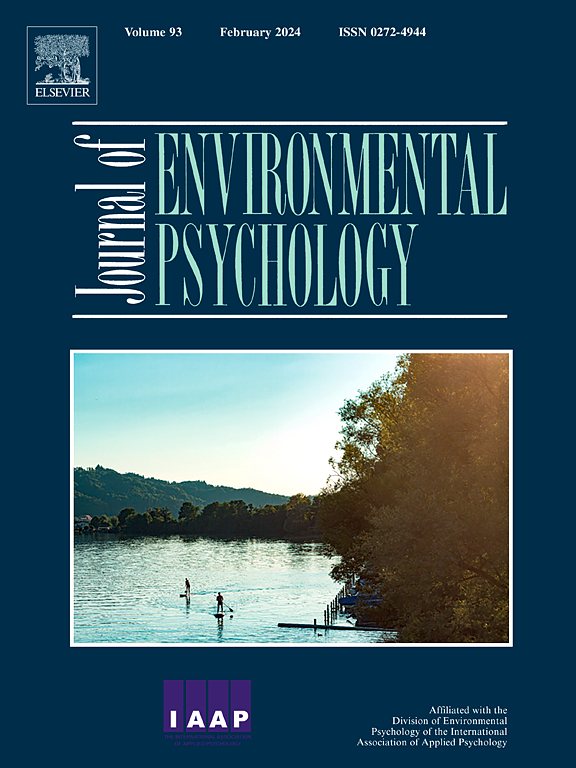Would you put your sustainability on display? Preferences for the visibility of sustainable household energy measures in the Netherlands
IF 7
1区 心理学
Q1 ENVIRONMENTAL STUDIES
引用次数: 0
Abstract
The visibility of sustainable energy measures is a channel of social influence, a means of conspicuous consumption, and affects the aesthetics of an environment. This study investigates how the visibility of sustainable household energy measures (i.e., installation of renewable energy and energy efficient devices) affects people's choices of those products in the Netherlands. In addition, the moderating effects of product attributes, including price, aesthetic appeal, environmental impact, and popularity, are assessed. A choice experiment was conducted in which participants chose between options of heat pumps and solar panels. The results indicate that visibility decreases the probability that a person chooses a heat pump, whereas visibility does not affect the choice of solar panels. For heat pumps, a higher aesthetic appeal mitigates the negative effect of visibility. Interestingly, a more positive environmental impact worsens the negative effect of visibility on the choice of heat pumps. The study suggests that visibility is not influential for choices of sustainable energy measures that have been part of the street scenery for a while, such as solar panels. For devices of which presence is unfamiliar, visibility is perceived as negative and considered a reason to choose another model. For a decision about whether to visibly install unfamiliar sustainable energy measures, expression of aesthetic style is a positive and influential factor, whereas increased environmentalism negatively affects choice.
你会展示你的可持续发展吗?荷兰对可持续家庭能源措施可见性的偏好
可持续能源措施的可见性是社会影响的渠道,是炫耀性消费的手段,并影响环境的美学。本研究调查了可持续家庭能源措施(即可再生能源和节能设备的安装)的可见性如何影响荷兰人们对这些产品的选择。此外,还评估了产品属性的调节作用,包括价格、审美吸引力、环境影响和受欢迎程度。进行了一个选择实验,参与者在热泵和太阳能电池板之间进行选择。结果表明,能见度降低了人们选择热泵的可能性,而能见度不影响太阳能电池板的选择。对于热泵,更高的审美吸引力减轻了能见度的负面影响。有趣的是,更积极的环境影响加剧了能见度对热泵选择的负面影响。该研究表明,能见度对可持续能源措施的选择没有影响,这些措施已经成为街景的一部分,比如太阳能电池板。对于存在不熟悉的设备,可见性被认为是负面的,并被认为是选择另一种模型的原因。对于是否安装不熟悉的可持续能源措施的决定,审美风格的表达是一个积极的影响因素,而环境保护主义的增加则对选择产生负面影响。
本文章由计算机程序翻译,如有差异,请以英文原文为准。
求助全文
约1分钟内获得全文
求助全文
来源期刊

Journal of Environmental Psychology
Multiple-
CiteScore
10.60
自引率
8.70%
发文量
140
审稿时长
62 days
期刊介绍:
The Journal of Environmental Psychology is the premier journal in the field, serving individuals in a wide range of disciplines who have an interest in the scientific study of the transactions and interrelationships between people and their surroundings (including built, social, natural and virtual environments, the use and abuse of nature and natural resources, and sustainability-related behavior). The journal publishes internationally contributed empirical studies and reviews of research on these topics that advance new insights. As an important forum for the field, the journal publishes some of the most influential papers in the discipline that reflect the scientific development of environmental psychology. Contributions on theoretical, methodological, and practical aspects of all human-environment interactions are welcome, along with innovative or interdisciplinary approaches that have a psychological emphasis. Research areas include: •Psychological and behavioral aspects of people and nature •Cognitive mapping, spatial cognition and wayfinding •Ecological consequences of human actions •Theories of place, place attachment, and place identity •Environmental risks and hazards: perception, behavior, and management •Perception and evaluation of buildings and natural landscapes •Effects of physical and natural settings on human cognition and health •Theories of proenvironmental behavior, norms, attitudes, and personality •Psychology of sustainability and climate change •Psychological aspects of resource management and crises •Social use of space: crowding, privacy, territoriality, personal space •Design of, and experiences related to, the physical aspects of workplaces, schools, residences, public buildings and public space
 求助内容:
求助内容: 应助结果提醒方式:
应助结果提醒方式:


